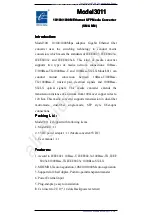
DVS 510 Series • Reference Information
119
Local and remote devices
The local and remote devices are defined from the point of view of the function being
described. In this guide, subnetting is an issue when you are using the controlling computer
to set TCP/IP and e-mail values in the DVS (see
Establishing an Ethernet Connection
Using TCP
on page 49. When you are setting up the variables for e-mail notification, the
scaler is the local device and the e-mail server is the remote device.
IP addresses and octets
Valid IP addresses consist of four 1-, 2-, or 3-digit numeric sub-fields, called “octets,” which
are separated by dots (periods) (see the illustration at
right). Each octet can be numbered from 000 through
255. Leading zeros, up to three digits total per octet, are
optional. Values of 256 and above are invalid.
Subnet masks and octets
The subnet mask (figure 52) is used to determine whether the local and remote devices are
on the same subnet or different subnets. The subnet mask consists of four numeric octets
separated by dots. Each octet can be numbered from 000 through 255. Leading zeros, up
to three digits total per octet, are optional. Each octet typically contains either 255 or 0. The
octets determine whether or not the same octets of two IP addresses will be compared
when determining if two devices are on the same subnet.
255.255.0.0
Typical Subnet Mask:
Octets
255 indicates that this octet will be
compared between two IP addresses.
0 indicates that this octet will
not
be
compared between two IP addresses.
Figure 52.
Subnet Mask and Octets
Determining whether devices are on the same subnet
To determine the subnet, the local device IP address is compared to the remote device IP
address (see figure 53). The octets of each address are compared or not, depending on the
value in the related subnet mask octet.
•
If a subnet mask octet contains the value 255, the related octets of the local device
address and the remote device IP address are unmasked.
Unmasked octets are compared (indicated by
?
in figure 53).
•
If the subnet mask octet contains the value 0, the related octets of the local device and
remote device IP addresses are masked.
Masked octets are not compared (indicated by
X
in figure 53).
If the unmasked octets of the two IP addresses match (indicated by
=
in example 1 of
figure 53), the two addresses are on the same subnet.
If the two unmasked fields do not match (indicated by an unequal sign (
≠
) in figure 53,
examples 2 and 3), the addresses are not on the same subnet.
192.168.254.254
255.255.0.0 (
?
.
?
.
X
.
X)
192.168.2.25
=
.
=
.
X
.
X
—
Match
(Same subnet)
(Different subnet)
(Different subnet)
Local IP Address:
Subnet Mask:
Remote IP Address:
Match?:
Example 1
Example 2
192.168.254.254
255.255.0.0 (
?
.
?
.
X
.
X)
190.190.2.25
≠
.
≠
.
X
.
X
—
No match
Example 3
192.168.254.254
255.255.0.0 (
?
.
?
.
X
.
X)
192.190.2.25
=
.
≠
.
X
.
X
—
No match
Figure 53.
Comparing the IP Addresses
192.168.254.254
Typical IP Address:
Octets


































